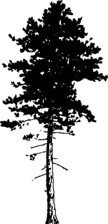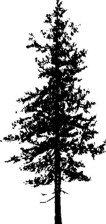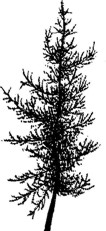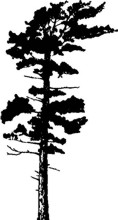|
SILVICS OF RED PINE Common names: Field identification aids: Average mature tree: Maximum life span: Shade Tolerance: Rooting: Windfirmness: Reproduction: Growing sites: Principal damaging agents: Notes: |
|
|||
|
||||
Lesson Two - Softwood Tree Identification and Silvics
To practice silviculture in Nova Scotia it is essential to recognize common trees. Once a tree is identified you can understand its rooting habit, windfirmness, associated species, favored growing sites and shade tolerance. With this information you can make an informed decision about the trees on your woodlot. For more information about common trees in Nova Scotia consult Trees of Nova Scotia (Saunders, 1995).
Lesson Two and Three briefly discuss soil types and characteristics. More information on soils can be found in Module 7 (Woodlot Ecology). For help in determining the type of soil on your woodlot consult the Forest Ecosystem Classification Guide published by the Nova Forest Alliance (Keys et al. 2003) listed in the ‘Further Reading’ section of this module.
This lesson presents the silvics and field identification characteristics of softwood trees in Nova Scotia. The section entitled “Average Mature Trees” has been included as a rough guide to help with identification. An average tree does not exist.
Silvics of Balsam Fir
|
SILVICS OF BALSAM FIR Common names: Field identification aids: Average mature tree: Maximum life span: Shade Tolerance: Rooting: Windfirmness: Reproduction: Growing sites: Principal damaging agents: Notes: |
|
|||
|
||||
Silvics of Black Spruce
|
SILVICS OF BLACK SPRUCE Common names: Field identification aids: Average mature tree: Maximum life span: Shade Tolerance: Rooting: Windfirmness: Reproduction: Growing sites: Associated species: Principal damaging agents: Notes: |
|
|||
|
||||
Silvics of Eastern Hemlock
|
SILVICS OF EASTERN HEMLOCK Common names: Field identification aids: Average mature tree: Maximum life span: Shade tolerance: Rooting: Windfirmness: Reproduction: Growing sites: Associated species: Notes: |
|
|||
|
||||
Silvics of Jack Pine
|
SILVICS OF JACK PINE Common names: Field identification aids: Average mature tree: Maximum life span: Shade Tolerance: Rooting: Windfirmness: Reproduction: Growing sites: Associated species: Principal damaging agents: Notes: |
|
|||
|
||||
Silvics of Red Pine
Silvics of Red Spruce
|
SILVICS OF RED SPRUCE Common names: Field identification aids: Average mature tree: Maximum life span Shade tolerance: Rooting: Windfirmness: Reproduction: Growing sites: Associated species: Principle damaging agents: Notes: |
|
||
|
|||
Silvics of Tamarack
|
SILVICS OF TAMARACK Common names: Field identification aids: Average mature tree: Maximum life span: Shade tolerance: Rooting: Windfirmness: Reproduction: Growing sites: Principal damaging agents: Notes: |
|
|
|
Return to Tree Identification |
Silvics of White Pine
|
SILVICS OF WHITE PINE Common names: Field identification aids: Average mature tree: Maximum life span: Shade Tolerance: Rooting: Windfirmness: Reproduction: Growing sites: Principal damaging agents: Notes: |
|
|||
|
||||
Silvics of White Spruce
|
SILVICS OF WHITE SPRUCE Common names: Field identification aids: Average mature tree: Maximum life span: Shade tolerance: Rooting: Windfirmness: Reproduction: Associated species: Growing sites: Principal damaging agents: Notes: |
|
|||
|
||||

















